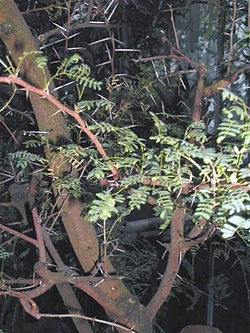| Vachellia horrida | |
|---|---|
 | |
| Scientific classification | |
| Kingdom: | Plantae |
| Clade: | Tracheophytes |
| Clade: | Angiosperms |
| Clade: | Eudicots |
| Clade: | Rosids |
| Order: | Fabales |
| Family: | Fabaceae |
| Subfamily: | Caesalpinioideae |
| Clade: | Mimosoid clade |
| Genus: | Vachellia |
| Species: | V. horrida |
| Binomial name | |
| Vachellia horrida | |
| Subspecies [2] | |
| |
 | |
| Range of Vachellia horrida | |
| Synonyms [3] | |
Vachellia horrida is a low spreading shrub or sometimes tree native to both the wet and dry scrublands of tropical to subtropical East Africa. [4] Common names for it are Cape gum, Karroo Thorn and dev-babul. [5] It is also found elsewhere in Africa, Asia, India and South America. [3] It frequently has stipular spines 9.5 cm long. [4] [6] V. horrida is an important browse plant in the tropics, particularly during the dry season. [7]